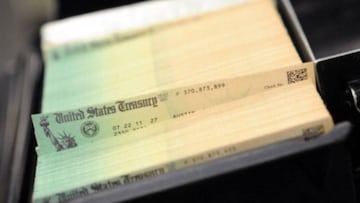Third stimulus check: how many people are still waiting for it?
The IRS announced that it has sent a new batch of $1,400 stimulus checks, including payments to individuals who hadn’t yet received their $1,400 payment.

The IRS is sending out weekly batches of $1,400 stimulus check payments and will do so through the end of the year. As the IRS processes 2020 tax returns, they will make corrections to underpayments along with first time payments to individuals who don’t normally file taxes.
This was week 6 of the payments and so far the IRS has sent out around 161 million payments for a total value of more than $379 billion. The latest batch added 2 million payments to the total, with slightly over half disbursed as paper checks.
The final amount of the third stimulus check depends on 2020 tax returns
The IRS sent out the $1,400 payments for the third round of stimulus checks automatically based on the information the agency had on file. Since the $1,400 payments were authorized in the middle of the 2021 tax season, the agency used 2019 or 2020 tax returns to judge eligibility and how much was due to each filer.
This meant that some received a smaller Economic Impact Payment (EIP) than they were expecting. However, as the IRS processes 2020 tax returns, they will be sending “plus-up” payments with each weekly batch.
However, if the IRS doesn’t have information from a 2019 tax return the agency had to wait until they receive a taxpayer’s 2020 tax return and it could be processed before issuing a payment. This was the case for 700,000 of the payments that went out this week with a value of more than $1.3 billion. Those checks averaged about $1,850 each.
You can’t get a stimulus check unless you file a tax return
Upon taking office, President Joe Biden issued an executive order to the US Treasury Department to consider changing its delivery structure to ensure the EIPs reached some 8 million eligible Americans who had not yet received the financial assistance. These were mainly Americans who don’t normally file a tax return and don’t receive federal benefits. Without any current information on file the tax agency could not send them a stimulus check.
These people are referred to as “Non-filers” because their income is too low to require them to file a tax return. They include those experiencing homelessness, the rural poor and others.
The IRS offered an online “Non-filers” tool last year for the purpose of giving their information to the tax agency so that they could receive a check. However, that tool was shut down in November and there are no plans to bring it back online. Now a “Non-filer” must file a 2020 tax return to get all of the three rounds of EIP.
How to get your third stimulus check and more
The third stimulus check will be sent as an advance payment for the Recovery Rebate Credit on the 2021 tax filing while the first two payments can be claimed as the 2020 Recovery Rebate Credit. The IRS recommends that these people file a 2020 tax return to get any EIP payments due to them as well as all the benefits they're entitled to under the law through the American Rescue Plan.
One of the most important may be the enhanced Child Tax Credit that will provide families with a refundable tax credit worth $3,000 for each child aged 6 to 17 and $3,600 for children under 6. Half that credit can be received in monthly installments if the taxpayer chooses. The IRS will begin sending out payments on the 2021 Child Tax Credit this summer.
The IRS offers a Free File service that anyone who earns less than $72,000 can use to file a federal tax return for free.
- IRS
- Coronavirus stimulus checks
- USA coronavirus stimulus checks
- Child benefits
- Covid-19 economic crisis
- Science
- Social support
- Coronavirus Covid-19
- Economic crisis
- Inland Revenue
- Pandemic
- Coronavirus
- Recession
- Economic climate
- Virology
- Outbreak
- Infectious diseases
- Public finances
- Social policy
- Microbiology
- Diseases
- Medicine
- Economy
- Finances
- Society
- Health
- Life sciences
- Biology






